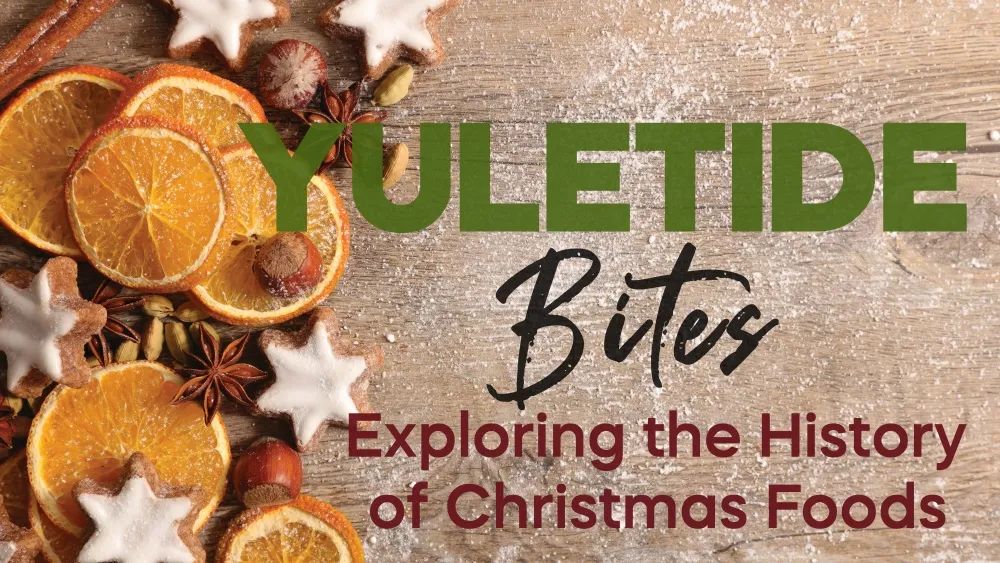
Yuletide Bites: Exploring the History of Christmas Foods
December 2023
by renata haidle
Have you ever wondered about the history of our beloved Christmas food traditions? Why do we eat the things we eat? Who made them popular? As unexpected as it might sound, a recent visit to England’s Hampton Court made me ponder the topic and gave some clues.
Among many relics reminiscent of King Henry VIII‘s reign, the palace kitchens were key to exploring the culinary customs of the Middle Ages. Spread out on about a quarter of the palace footprint; they were highly evocative of medieval banquets. One could easily picture the well-stocked pantries, the fresh game and produce, the sophisticated sweets, and the meats roasting over an open fire - all tended by a small army of kitchen staff. Just imagine a Christmas feast at the opulent Tudor court, where even a regular day offered meals of gargantuan proportions.
Those days might be long gone, and yet, at Christmas, we go all out: the good china, the festive tablecloth, and abundant food to share with friends and family. What remains of our ancestors’ favorites that we still enjoy today? Let's grab a warm winter drink and look at how some of our most-loved dishes made their way onto our Christmas table.
Roast Turkey: A Time-Honored Tradition
When it comes to Christmas dinner, few dishes can claim the spotlight quite like the roast turkey. Its history is intertwined with the story of Thanksgiving, but this oh-so-popular bird has become equally synonymous with Christmas. The turkey's place of honor on the Christmas table can be traced back to England and the 19th century when it became a symbol of abundance and celebration. In Charles Dickens' A Christmas Carol, the Cratchit family famously feasts on a prized turkey, cementing its association with the holiday.
Cranberry Sauce: A Tart & Tangy Companion
No turkey dinner is complete without a dollop of cranberry sauce. This bright and tangy condiment adds a burst of color and flavor to the festive spread. Native to North America, Indigenous People have used cranberries in culinary preparations for centuries. By the 18th century, cranberry sauce was a popular accompaniment to holiday feasts. The earliest recipe for it appears in the 1796 edition of American Cookery by Amelia Simmons - the first known cookbook authored by an American.
Stuffing: A Comforting Sidekick
Stuffing, also known as dressing, when baked outside the bird, is a heartwarming blend of bread, herbs, vegetables, and sometimes sausage or oysters. This comforting side dish traces its roots to European settlers who brought their stuffing recipes to the New World - although mentions of its existence seem to go way back to the Roman Empire. Victorian England has changed its name from stuffing to dressing, considering it a more polite appellation.
Fruitcake: The Controversial Confection
Few Christmas foods elicit such passionate opinions as fruitcake. While it may be the butt of many jokes (“There is only one fruitcake in the entire world, and people keep sending it to each other,” comedian Johnny Carson allegedly said), it is also a deeply traditional dessert with a rich history. Fruitcakes were mentioned as early as ancient Egypt and were later embraced by the Romans, who introduced them to Europe. The fruitcake's association with Christmas dates back to medieval England when dried fruits, spices, and honey were preserved for the winter and then used in holiday cakes. In America, fruitcakes have been a beloved, albeit polarizing, tradition for centuries. They are often soaked in spirits like brandy or rum, allowing flavors to meld and develop over time.
Candy Canes: The Sweet Symbols of Christmas
Candy canes are perhaps America's most iconic Christmas candy, instantly recognizable by their red and white stripes and hook shape. These sugary treats have a history that dates back several centuries. The candy cane's origins are somewhat debated, with theories ranging from its connection to German choirmaster bent staffs to its association with the Nativity. Candy canes became a popular Christmas confection in the 19th century. Today, they adorn Christmas trees and find their way into stockings as cherished holiday symbols.
Gingerbread: A Sweet Work of Art
Gingerbread, another product of medieval Europe, arrived in the New World with early European colonists, quickly becoming a favorite during the holiday season. The sweet, spiced bread evolved into gingerbread cookies, houses, and men. Today's elaborately decorated gingerbread houses trace their origins to Germany and the Brothers Grimm’s fairy tales.
The Yule Log Cake: From Pagan Tradition to Christian Symbolism
The Yule Log cake, or bûche de Noël in French, also originates in medieval Europe. Its history is rooted in both pagan and Christian traditions. The large wooden yule log was an integral part of winter solstice celebrations in Scandinavian and Celtic pagan cultures, symbolizing the triumph of light over darkness. With the spread of Christianity, the yule log took on a new meaning as a symbol of the Christmas story. In the late 19th century, the tradition of the yule log cake as we know it today began to emerge in France. Parisian pastry chefs created a cake shaped like a log to be served at Christmas celebrations.
Depending on your heritage, other foods might appear at the Christmas table. A Scandinavian smörgåsbord, Mexican tamales, German stollen, Italian panettone (or its Slavic counterpart povitica), Norwegian lutefisk, and Romanian sarmale are just a few that come to mind.
No matter what foods will grace our Christmas celebration this year, let us remember that Christmas is about more than just the food on our plates. Let us appreciate the warmth of family gathered around the table, the laughter of friends, and the generosity of spirit that defines the season. Whether a humble mince pie or an extravagant roast, these Christmas foods are vessels for the joy, love, and togetherness that permeate the holiday season.
Originally printed in the December 2023 issue of Simply Local Magazine
Never miss an issue, check out SLM's digital editions here!





